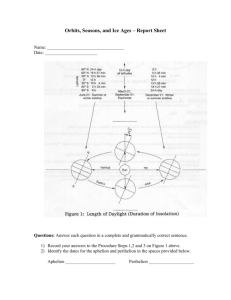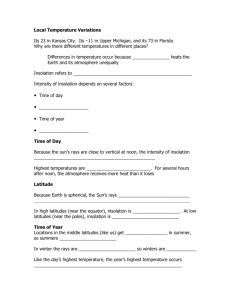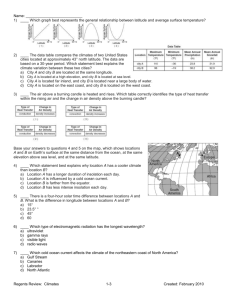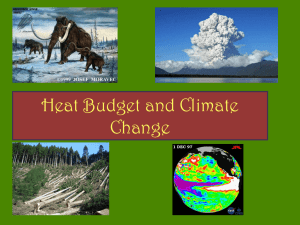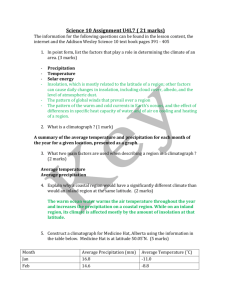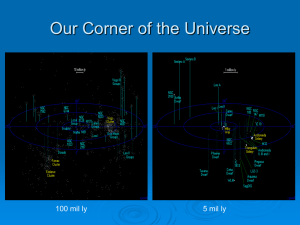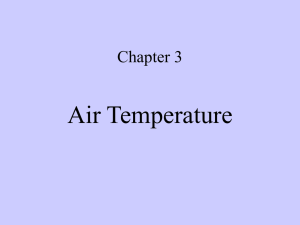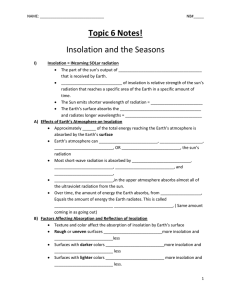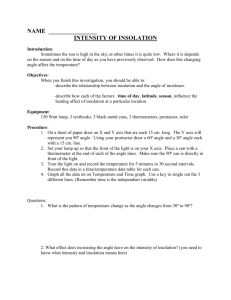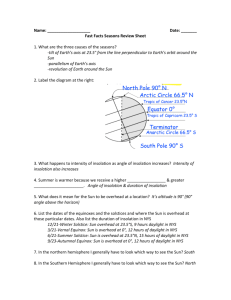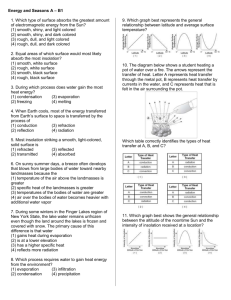Curriculum-Based Questions - High School of Language and
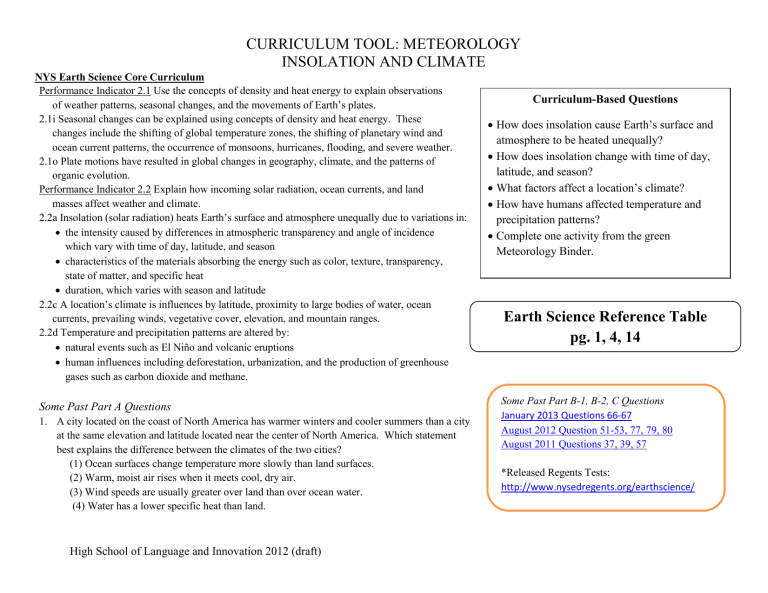
CURRICULUM TOOL: METEOROLOGY
INSOLATION AND CLIMATE
NYS Earth Science Core Curriculum
Performance Indicator 2.1 Use the concepts of density and heat energy to explain observations of weather patterns, seasonal changes, and the movements of Earth’s plates.
Curriculum-Based Questions
2.1i Seasonal changes can be explained using concepts of density and heat energy. These changes include the shifting of global temperature zones, the shifting of planetary wind and ocean current patterns, the occurrence of monsoons, hurricanes, flooding, and severe weather.
2.1o Plate motions have resulted in global changes in geography, climate, and the patterns of organic evolution.
Performance Indicator 2.2 Explain how incoming solar radiation, ocean currents, and land masses affect weather and climate.
2.2a Insolation (solar radiation) heats Earth’s surface and atmosphere unequally due to variations in:
the intensity caused by differences in atmospheric transparency and angle of incidence which vary with time of day, latitude, and season
characteristics of the materials absorbing the energy such as color, texture, transparency, state of matter, and specific heat
duration, which varies with season and latitude
2.2c A location’s climate is influences by latitude, proximity to large bodies of water, ocean currents, prevailing winds, vegetative cover, elevation, and mountain ranges.
2.2d Temperature and precipitation patterns are altered by:
natural events such as El Niño and volcanic eruptions
human influences including deforestation, urbanization, and the production of greenhouse gases such as carbon dioxide and methane.
Some Past Part A Questions
1.
A city located on the coast of North America has warmer winters and cooler summers than a city at the same elevation and latitude located near the center of North America. Which statement best explains the difference between the climates of the two cities?
(1) Ocean surfaces change temperature more slowly than land surfaces.
(2) Warm, moist air rises when it meets cool, dry air.
(3) Wind speeds are usually greater over land than over ocean water.
(4) Water has a lower specific heat than land.
How does insolation cause Earth’s surface and atmosphere to be heated unequally?
How does insolation change with time of day, latitude, and season?
What factors affect a location’s climate?
How have humans affected temperature and precipitation patterns?
Complete one activity from the green
Meteorology Binder.
Earth Science Reference Table pg. 1, 4, 14
Some Past Part B-1, B-2, C Questions
January 2013 Questions 66-67
August 2012 Question 51-53, 77, 79, 80
August 2011 Questions 37, 39, 57
*Released Regents Tests: http://www.nysedregents.org/earthscience/
High School of Language and Innovation 2012 (draft)
CURRICULUM TOOL: METEOROLOGY
INSOLATION AND CLIMATE
2.
Global warming is most likely occurring due to an increase in
(1) carbon dioxide and methane gases in the atmosphere
(2) oxygen and nitrogen gases in the atmosphere
(3) ultraviolet radiation and x rays reflected from Earth
(4) visible light and radio waves reflected from Earth
3. Which natural event temporarily slows or reverses surface ocean currents in the equatorial region of the Pacific Ocean, causing a disruption of normal weather patterns?
(1) monsoons (2) volcanic eruptions (3) El Niño (4) deforestation
Readings
Holt (yellow book) pg.
631-640 (climate),
672-674 (seasons)
Glencoe (big blue book) pg. 359-368
(climate), 372-373
(insolation)
McGuire (little blue book) pg. 453-
462(seasons and insolation), 580-593
(climate)
Unison Reading
Binder: Meteorology
Resources for Learning
Websites
Sun Angle, Duration, and Insolation http://academic.cengage.com/resource_uploads/do wnloads/0495555061_137179.pdf
What on Earth affects Climate? http://www.eo.ucar.edu/kids/green/warming5.htm
What affects climate? http://learnearthscience.com/pages/For_Teachers/U nit%20Notes/unitnotespdf.html
Changes in Insolation http://www.cliffsnotes.com/study_guide/Changes-in-
Insolation.topicArticleId-24060,articleId-24047.html
What is Climate? http://www.windows2universe.org/earth/climate/cli
_define.html
Regents Review Materials http://regentsprep.org
http://reviewearthscience.com/ http://regentsearth.com/
Foreign Language:
¿Qué es el clima?
Videos
Insolation and Seasons http://teacherweb.com/NY/NewfieldHS/Adwar/apt15.aspx
Meteorology: Climate Animations http://hmxearthscience.com/climate.html
Climate and Weather http://video.nationalgeographic.com/video/science/earthsci/climate-weather-sci/
The Effects of Jet Streams on Climate http://www.teachersdomain.org/resource/ttv10.sci.ess.jet/
Inside the Megastorm (Hurricane Sandy) https://www.diigo.com/bookmark/http%3A%2F%2Fvideo.pbs.o
rg%2Fvideo%2F2305482040?tab=people&uname=zachmiller
At home:
Climate and Weather http://www.youtube.com/watch?v=0NrzDK0lewo&list=PL8371
8807F4705ADF&index=3
The Greenhouse Effect http://www.youtube.com/watch?v=KBSiHtfO2N8&list=PL83718
807F4705ADF&index=59
Sun’s Path http://www.youtube.com/watch?v=risM55KG2h8&list=PL8371
8807F4705ADF&index=25 http://www.windows2universe.org/earth/climate/cli
_define.html&lang=sp
Activities
Meteorology
Binder
Insolation and
Climate
Vocabulary
High School of Language and Innovation 2012 (draft)
